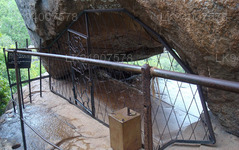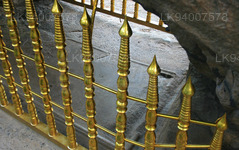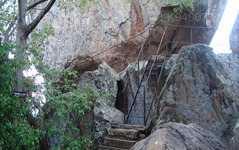
Ciudad de Anuradhapura
Anuradhapura pertenece a la Provincia Central del Norte de Sri Lanka. Anuradhapura es una de las antiguas capitales de Sri Lanka, famosa por sus ruinas bien conservadas de la antigua civilización de Sri Lanka. La ciudad, declarada Patrimonio de la Humanidad por la UNESCO, se encuentra a 205 km al norte de la actual capital, Colombo, en Sri Lanka.
Mihindu Cave
Mihinthale, considered the cradle of Buddhism in Sri Lanka, is where the great Mahinda Thero stopped king Devanampiyatissa who was chasing after a deer during a royal hunting ceremony to deliver the greatest gift Emperor Asoka (of India) could offer his friend. Once the Buddhism was established in the country, Mihinthale was developed throughout the millennia by many kings as massive monastic complex complete with hospitals for the sick bhikkhus.
After the Aradhana Gala, the rock of invitation, Mihindu Guhawa (the Cave of Mahinda Thero) where the place where the great Arahat sat and meditated is one of he most interesting sites on this monastic complex. This rock shelter with a stunning view, has his seat is carved into the rock.
When one climbs down about three hundred yards on to the eastern side passing the site of the Sila Cetiya at Mihintale, one reaches a stone slab sheltered by another rock called Mihindu Guhawa. When one returns to the Maluwa or the plateau. the Mahasaya, great Stupa and the Mihindu Saya are there on the summit of the mountain to the south. The rock which has about 110 inbuilt steps besides the steps cut into the rock. Each step is about 12 feet long, 1 feet wide and about 6 inches high.
Acerca del distrito de Anuradhapura
Anuradhapura pertenece a la Provincia Central del Norte de Sri Lanka. Anuradhapura es una de las antiguas capitales de Sri Lanka, famosa por sus ruinas bien conservadas de la antigua civilización de Sri Lanka. La ciudad, declarada Patrimonio de la Humanidad por la UNESCO, se encuentra a 205 km al norte de la actual capital, Colombo, en Sri Lanka. En la ciudad sagrada de Anuradhapura y sus alrededores se encuentran numerosas ruinas. Estas consisten en tres tipos de edificios: dagobas, edificios monásticos y pokuna (estanques). La ciudad contaba con algunos de los sistemas de riego más complejos del mundo antiguo. Ubicada en la zona árida del país, la administración construyó numerosos tanques para regar la tierra. La mayoría de la población civil es cingalesa, mientras que en el distrito viven tamiles y moros de Sri Lanka.
Acerca de la Provincia Central del Norte
La Provincia Central del Norte, que es la provincia más grande del país, cubre el 16% de la superficie total del país. La Provincia Central del Norte consta de dos distritos llamados Polonnaruwa y Anuradhapure. Anuradhapura es el distrito más grande de Sri Lanka. Su área es de 7.128 km². La Provincia Central del Norte tiene numerosos potenciales para que los inversores inicien sus negocios, especialmente la agricultura, las industrias basadas en la agricultura y los sectores ganaderos. Más del 65% de la gente de la Provincia Central del Norte depende de la agricultura básica y las industrias basadas en la agricultura. NCP también se llama "Wew Bendi Rajje" porque hay más de 3.000 tanques de escala mediana y grande situados en la provincia. Sri maha bodiya, Ruwanweli seya, Thuparama dageba, Abayagiri Monastry, Polonnaruwa Rankot wehera, Lankathilake están asustados














